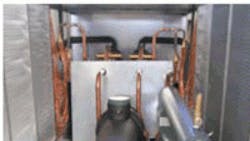Illinois Village Uses Heat-Recovery Chiller to Boost Efficiency of Police Station
In 2005, the Village of Skokie, Ill., conducted a space-needs study that concluded the Skokie Police Station, built in 1957, no longer was suitable to service the community.
A detailed search led to the purchase of an old concrete production facility that was stripped down to the original cement floor, pillars, and slab roof. SRBL Architects of Deerfield, Ill., determined an underfloor-air-distribution system to be the most effective means of heating, ventilating, and air conditioning the 80,000-sq-ft structure, avoiding the extensive ducting that otherwise would have been required. Interior walls were installed above the raised floor, providing a common pressurized underfloor plenum to service the entire conditioned space.
Ed Chrzastowski of Consolidated Consultants in Wheeling, Ill., was tasked with designing an HVAC system both reliable and highly efficient. He designed the system around an air-cooled chiller supplying a primary air handler and 14 secondary underfloor variable-air-volume boxes.
The underfloor system distributes air that is somewhat warmer than the air normally distributed by a traditional overhead ducted system. While that is essential to avoiding "cold-feet syndrome," it presented a design challenge: avoiding condensation on underfloor concrete surfaces. Supply air is dehumidified by being cooled to below its dew point and then reheated to the design supply temperature of 60°F. Dew-point sensors mounted in the underfloor plenum reset the temperature of chilled water supplied to the primary air handler, enabling on-demand dehumidification during summer. The primary air handler cools air to 52°F using 40°F entering chilled water. Any excess moisture is stripped from the air, which immediately is reheated in a hot-water coil before being delivered to the underfloor plenum.
The most efficient means of accomplishing reheat was determined to be recovering the required heating capacity from a 170-ton Motivair air-cooled chiller with simultaneous heat recovery. The Motivair chiller provides the required reheat capacity for the Skokie Police Department at effectively zero cost by recovering heat that otherwise would be rejected to the atmosphere.
While supplying 40°F chilled water to the primary air handler, the chiller provides a 115°F secondary hot-water loop. Water is returned to the chiller at 105°F. Hot gas from the chiller's two screw compressors passes through two shell-and-tube heat-recovery condensers piped in series with the air-cooled condensers. This is a passive heat-recovery system allowing the hot-water loop to recover as much heat as required at any time. Excess heat simply continues to the air-cooled condensers, where it is rejected from the system. This is the primary source of reheat energy for the Skokie Police Station and eliminates the use of boiler water or electrical power for reheating during summer.
The Motivair chiller is capable of recovering up to 175 tons (2,109,595 Btuh) of heat under standard design conditions. In this application, 80 tons of recovered heat is used. Despite glycol-efficiency reductions and the inherent efficiency loss associated with the production of low-temperature water, the chiller exceeds ANSI/ASHRAE/IESNA Standard 90.1, Energy Standard for Buildings Except Low-Rise Residential Buildings, achieving an energy-efficiency rating (EER) of 10.4.
With the ability to provide simultaneous heating and cooling, a heat-recovery chiller can achieve EERs of 20 and higher, depending on how it is applied and the amount of available heat that is utilized. Hospitals and hotels are ideal applications for heat-recovery chillers. Maximum energy efficiency is achieved in warmer climates when chiller operation and simultaneous heat recovery are required around the clock throughout the year. In the case of the Skokie Police Station, the chiller acts as a permanent air-to-water heat pump while providing the required cooling capacity and reducing the carbon footprint.
The Skokie Police Station is expected to achieve a LEED Silver or Gold rating.
For Design Solutions author guidelines, call Scott Arnold, executive editor, at 216-931-9980, or write to him at [email protected].
